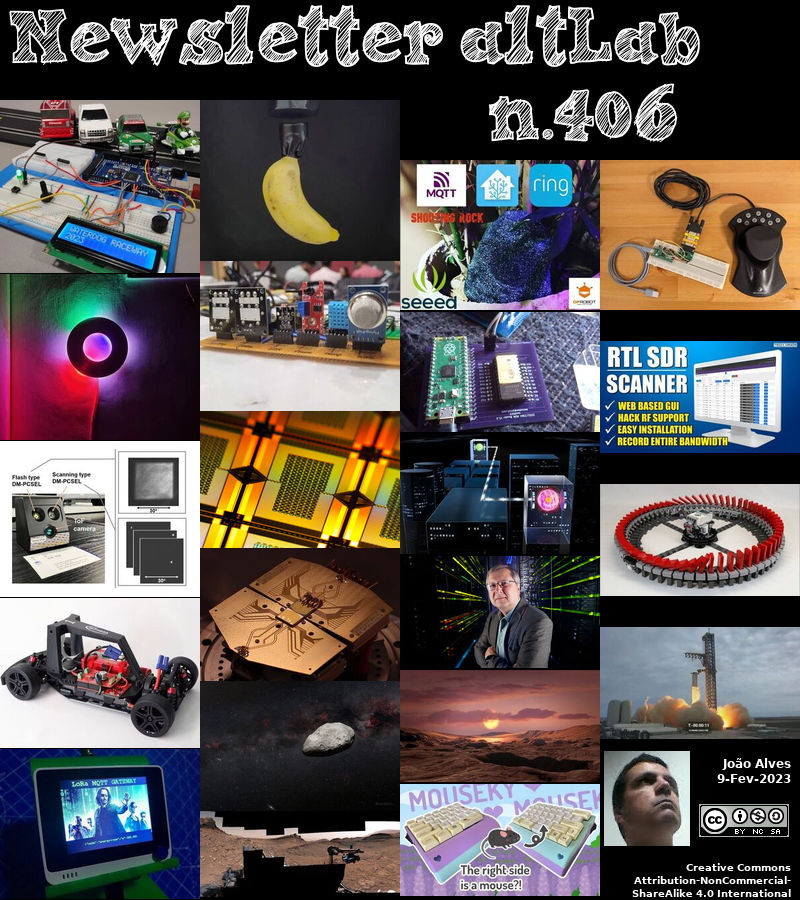2023-02-09 - Nº 406
Editorial
Esta é a Newsletter Nº 406 que se apresenta com o mesmo formato que as anteriores. Se gostar da Newsletter partilhe-a!
Todas as Newsletters encontram-se indexadas no link.
Esta Newsletter tem os seguintes tópicos:
Faz hoje anos que nascia, em 1775, o matemático, poeta e dramaturgo húngaro Farkas Bolyai. Ele passou uma vida inteira a tentar provar o postulado de Euclides (quinto) de que as linhas paralelas não se encontram. Enquanto estudava na Universidade de Göttingen, conheceu como colega, o notável matemático alemão Carl F. Gauss, com quem correspondia como amigo de toda a vida. Bolyai ensinou matemática, física e química em Marosvásárhely durante toda a sua vida.
Faz também hoje anos que nascia, em 1846, o engenheiro e desenhador alemão Wilhelm Maybach. Ele inventou o carburador spray e foi o designer-chefe dos primeiros automóveis Mercedes (1900-01). Aos 26 anos, começou a desenhar carros com Gottlieb Daimler e Nikolaus Otto, com quem desenvolveu o ciclo do motor a quatro tempos. Em Abril de 1882, Maybach juntou-se a Gottlieb Daimler numa parceria para produzir um motor a gasolina leve e de alta velocidade adequado para veículos. Maybach inventou o carburador de alimentação flutuante (1893) no qual o combustível era vaporizado passando por um jacto como um spray fino e misturado com ar para produzir uma mistura combustível para o motor. Maybach concebeu o primeiro carro Mercedes para a Daimler em 1901, mas reformou-se em 1907 para conceber e fabricar motores para os dirigíveis Zeppelin. O seu filho, Karl Maybach, seguiu-o na produção de automóveis de luxo.
Por fim, faz hoje anos que nascia, em 1910, o bioquímico francês Jacques Monod. Ele, juntamente com François Jacob, investigou como os genes regulam o metabolismo celular dirigindo a biossíntese das enzimas. A dupla partilhou (com André Lwoff) o Prémio Nobel da Medicina de 1965. Monod descobriu o sistema operon que controla a acção dos genes nas bactérias.
Em 1996, pouco mais de um ano após terem criado o elemento 111, uma equipa de cientistas alemães liderada por Peter Armbruster na Gesellschaft für schwerionenforschung (GSI) em Darmstadt, Alemanha, afirmou ter criado um átomo do elemento 112. O seu núcleo tem 112 prótons e 166 neutrões, dando-lhe um número de massa de 277. Como novo elemento, foi nomeado ununbium, símbolo Uub, de acordo com um sistema adoptado internacionalmente para nomear novos elementos. Isto foi baseado na presença de um átomo do elemento feito acelerando os átomos de zinco a alta velocidade e bombardeando-os para chumbo. Quando um átomo de cada um se fundiu para fazer o novo núcleo, este durou uma fracção de milésimo de segundo antes de se decompor, emitindo uma partícula alfa para se tornar um núcleo do elemento 110. Mais tarde este elemento passaria a chamar-se Copernício e ter o símbolo Cn.
Na Newsletter desta semana apresentamos diversas noticias, artigos científicos, projetos de maker e alguns vídeos interessantes.
 João Alves ([email protected])
João Alves ([email protected])
O conteúdo da Newsletter encontra-se sob a licença  Creative Commons Attribution-NonCommercial-ShareAlike 4.0 International License.
Creative Commons Attribution-NonCommercial-ShareAlike 4.0 International License.
Novidades da Semana

CircuitPython 8.0.0 Released
"This is CircuitPython 8.0.0, the latest major revision of CircuitPython, and is a new stable release. NOTE: Since 8.0.0-beta.6, the file for specifying startup values for WiFi, etc., is now called settings.toml instead of .env, and uses slightly different syntax. Use double quotes instead of single quotes. Further documentation is here. WARNING: The flash partitioning for 2MB and 4MB flash ESP32 and ESP32-C3 boards has changed since 8.0.0-beta.2. When you load 8.0.0-beta.3 or later over beta.2 (or vice versa), on these boards, CIRCUITPY will be erased and reformatted." [...]
Outras Notícias

NASA’s NuSTAR Telescope Reveals Hidden Light Shows on the Sun
"Some of the hottest spots in the Sun’s atmosphere appear in the telescope’s X-ray view. Even on a sunny day, human eyes can’t see all the light our nearest star gives off. A new image displays some of this hidden light, including the high-energy X-rays emitted by the hottest material in the Sun’s atmosphere, as observed by NASA’s Nuclear Spectroscopic Telescope Array (NuSTAR). While the observatory typically studies objects outside our solar system – like massive black holes and collapsed stars – it has also provided astronomers with insights about our Sun. In the composite image above (left), NuSTAR data is represented as blue and is overlaid with observations by the X-ray Telescope (XRT) on the Japanese Aerospace Exploration Agency’s Hinode mission, represented as green, and the Atmospheric Imaging Assembly (AIA) on NASA’s Solar Dynamics Observatory (SDO), represented as red. NuSTAR’s relatively small field of view means it can’t see the entire Sun from its position in Earth orbit, so the observatory’s view of the Sun is actually a mosaic of 25 images, taken in June 2022." [...]

Qualcomm Introduces the World's First 5G NR-Light Modem-RF System to Fuel a New Wave of 5G Devices
"Qualcomm Technologies, Inc. today announced Snapdragon® X35 5G Modem-RF System, the world’s first 5G NR-Light modem-RF system. NR-Light, a new class of 5G, fills the gap in between high-speed mobile broadband devices and extremely low-bandwidth NB-IoT devices. NR-Light devices, powered by Snapdragon X35, can be smaller, more cost-efficient, and provide longer battery life than traditional mobile broadband devices. With its optimized design and breakthrough performance, Snapdragon X35 offers a device platform that bridges the complexity and capability gap between the extremes in 5G today and addresses the need for mid-tier use cases. This lower cost option provides device makers with a long-term migration path to replace LTE CAT4+ devices, ultimately increasing 5G adoption and allowing for faster transition to a unified 5G network. In addition to Snapdragon X35, Qualcomm Technologies also announced Snapdragon® X32 5G Modem-RF System, a modem-to-antenna solution built to lower complexity and fuel cost-efficient NR-Light devices." [...]

Toshiba Releases Intelligent Power Devices That Help Reduce Mounting Areas
"Toshiba Electronic Devices & Storage Corporation ("Toshiba") has launched two intelligent power devices that control the drive of the inductive loads of motors, solenoids, lamps and other devices used in applications such as the programmable logic controllers of industrial equipment. Shipments of the high-side switch (8-channels) “TPD2015FN” and the low-side switch (8-channels) “TPD2017FN” start today. The new products use Toshiba’s analog device consolidation process (BiCD)[1] to achieve an on-resistance of 0.4Ω (typ.) in the output stage, over 50% lower than that of Toshiba’s current products[2]. Both TPD2015FN and TPD2017FN are housed in an SSOP30 package[3], which has a mounting area about 71% that of the SSOP24[4] package used for the current products[2], a height of 80% that of SSOP24 package, and a narrower, 0.65mm pin pitch. These improvements will help to reduce equipment size." [...]

NASA’s Curiosity Finds Surprise Clues to Mars’ Watery Past
"Among other discoveries made by the rover, rippled rock textures suggest lakes existed in a region of ancient Mars that scientists expected to be drier. When NASA’s Curiosity rover arrived at the “sulfate-bearing unit” last fall, scientists thought they’d seen the last evidence that lakes once covered this region of Mars. That’s because the rock layers here formed in drier settings than regions explored earlier in the mission. The area’s sulfates – salty minerals – are thought to have been left behind when water was drying to a trickle. So Curiosity’s team was surprised to discover the mission’s clearest evidence yet of ancient water ripples that formed within lakes. Billions of years ago, waves on the surface of a shallow lake stirred up sediment at the lake bottom, over time creating rippled textures left in rock." [...]

STMicroelectronics’ integrated flyback controller with advanced features boosts LED lighting performance
"STMicroelectronics’ HVLED101 90-400V flyback controller for LED-lighting applications up to 180W enhances performance and simplifies design through extensive feature integration, patented control techniques, and support for primary-sensing regulation. Joining ST’s HVLED family of high-power-factor controllers, the HVLED101 contains 800V startup circuitry that cuts the LED turn-on time to less than 250ms. High-voltage input-sensing circuitry and a maximum power control (MPC) engine are also integrated to ensure consistent power output as the line voltage fluctuates. This lets designers choose smaller and lower-cost external passive components to handle worst-case line conditions. Primary-sensing regulation without isolated feedback further reduces the bill of materials and enhances reliability. Among the patented innovations, ST’s input-current shaping algorithm lowers total harmonic distortion (THD) and maximizes the power factor." [...]

Webb Detects Extremely Small Main Belt Asteroid
"NASA’s newest astrophysics observatory wasn’t designed to look for small objects in our solar system, but scientists using its Mid-Infrared Instrument may have done just that. An asteroid roughly the size of Rome’s Colosseum – between 300 to 650 feet (100 to 200 meters) in length – has been detected by an international team of European astronomers using NASA’s James Webb Space Telescope. Their project used data from the calibration of the Mid-InfraRed Instrument (MIRI), in which the team serendipitously detected an interloping asteroid. The object is likely the smallest observed to date by Webb and may be an example of an object measuring under 0.6 miles (1 kilometer) in length within the main asteroid belt, located between Mars and Jupiter. More observations are needed to better characterize this object’s nature and properties. “We – completely unexpectedly – detected a small asteroid in publicly available MIRI calibration observations,” explained Thomas Müller, an astronomer at the Max Planck Institute for Extraterrestrial Physics in Germany." [...]

STMicroelectronics reveals scalable, feature-rich automotive high-side drivers leveraging advanced power technology
"STMicroelectronics has released single-, double-, and four-channel automotive High Side Drivers in a common PowerSSO-16 package style, with pin assignments that simplify scaling circuit designs to add more driver channels. The High Side Drivers target applications throughout the vehicle, including safety, comfort, and powertrain, body electronics, infotainment, and driver assistance systems. Meeting the automotive industry’s LV124 test schedule for deep cold cranking permits use with heavy loads such as engine starters and ensures reliable operation even in extreme winter conditions. With very low standby current, at just a few microamps, these drivers minimize the drain on the battery when the vehicle is turned off and not being used. The drivers are manufactured using ST’s proprietary VIPower M0-9 technology, which permits extensive integration within a small die size in addition to high current capability and high efficiency. On-chip features include protection such as load-current limiting, load-dump protection up to 35V, and limiting of fast thermal transients." [...]

SpaceX successfully test fires Starship booster in last key step before orbital launch
"SpaceX on Thursday test fired 31 of the 33 engines in the towering rocket booster of its Starship prototype, as the company prepares to launch the rocket to orbit for the first time. Called a “static fire,” the milestone test is the final major hurdle before SpaceX tries to launch the nearly 400-foot-tall rocket to space. The company said in a tweet shortly after the test that the engines at the base of the Super Heavy booster fired for “full duration,” meaning the expected length of the test. CEO Elon Musk said in a subsequent tweet that SpaceX turned off one engine before the test and another engine “stopped itself.” “Still enough engines to reach orbit!” Musk said. SpaceX has steadily been building up to the first flight test of its Starship rocket. President and COO Gwynne Shotwell on Wednesday stressed the first launch attempt would be experimental." [...]
Ciência e Tecnologia

An exoplanet that could host life
"Astronomers find rare Earth-mass rocky planet suitable for the search for signs of life A newly discovered exoplanet could be worth searching for signs of life. Analyses by a team led by astronomer Diana Kossakowski of the Max Planck Institute for Astronomy describe a planet that orbits its home star, the red dwarf Wolf 1069, in the habitable zone. This zone includes distances around the star for which liquid water can exist on the surface of the planet. In addition, the planet named Wolf 1069 b has an Earth-like mass. Very likely, this planet is a rocky planet that may also have an atmosphere. This makes the planet one of the few promising targets to search for signs of life-friendly conditions and biosignatures." [...]
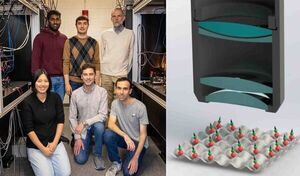
Princeton scientists measure quantum correlations between molecules for the first time
"Physicists are increasingly using ultracold molecules to study quantum states of matter. Many researchers contend that molecules have advantages over other alternatives, such as trapped ions, atoms or photons. These advantages suggest that molecular systems will play important roles in emerging quantum technologies. But, for a while now, research into molecular systems has advanced only so far because of long-standing challenges in preparing, controlling and observing molecules in a quantum regime. Now, as chronicled in a recent paper in the journal Nature, Princeton researchers have achieved a major breakthrough by microscopically studying molecular gases at a level never before achieved by previous research. The Princeton team, led by Waseem Bakr, associate professor of physics, was able to cool molecules down to ultracold temperatures, load them into an artificial crystal of light known as an optical lattice, and study their collective quantum behavior with high spatial resolution such that each individual molecule could be observed." [...]
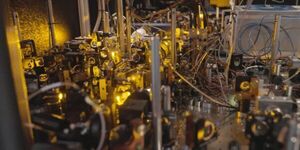
Quantum physics: Microwaves direct the interplay of waltzing molecules
"The existence of so-called super molecules has long been predicted theoretically. Now, a Munich team of researchers managed for the first time to create the conditions for proving these exotic entities. A team of researchers at the Max Planck Institute of Quantum Optics (MPQ) and the Cluster of Excellence MCQST has for the first time observed evidence of a phenomenon that had previously only been suspected: a theory predicts that exotic bound states can arise when ultracold polar molecules collide. Visible changes in the collision properties now indicate in the experiment that this effect is indeed possible. For their investigations, the researchers used a specifically shaped microwave field with which they can directly influence the interplay of various forces between the particles. In this way, “supermolecules” can form: comparatively large and just weakly linked constructs that can be controlled by the field of a microwave and whose existence affects the dynamics of collisions between unbound molecules." [...]
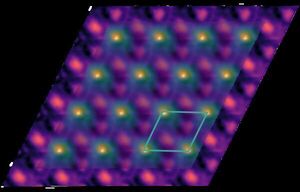
Microscopy Images Could Lead to New Ways to Control Excitons for Quantum Computing
"For the first time, scientists observe exciton quasiparticles confined in atomically thin materials, opening new paths to controlling excitons for quantum and optolectronic applications Excitons are drawing attention as possible quantum bits (qubits) in tomorrow’s quantum computers and are central to optoelectronics and energy-harvesting processes. However, these charge-neutral quasiparticles, which exist in semiconductors and other materials, are notoriously difficult to confine and manipulate. Now, for the first time, researchers have created and directly observed highly localized excitons confined in simple stacks of atomically thin materials. The work confirms theoretical predictions and opens new avenues for controlling excitons with custom-built materials. “The idea that you can localize excitons on specific lattice sites by simply stacking these 2D materials is exciting because it has a variety of applications, from designer optoelectronic devices to materials for quantum information science,” said Archana Raja, co-lead of the project and a staff scientist at Lawrence Berkeley National Laboratory’s (Berkeley Lab) Molecular Foundry, whose group led the device fabrication and optical spectroscopy characterization. The team fabricated devices by stacking layers of tungsten disulfide (WS2) and tungsten diselenide (WSe2)." [...]

Machine-learning models, guided by physics, will improve subsurface imaging
"Potential applications include energy exploration and earthquake early warning, among others A team of scientists at Los Alamos National Laboratory is applying machine-learning algorithms to subsurface imaging that will impact a variety of applications, including energy exploration, carbon capture and sequestration, and estimating pathways of subsurface contaminant transport, according to new research published in IEEE Signal Processing Magazine. “The subsurface is extremely complex and full of uncertainty, and knowledge of its physical properties is vital for a variety of applications,” said Youzuo Lin of Los Alamos’ Energy and Earth System Science group and lead author of the paper. “This paper is the first systematic survey on physics-guided machine-learning techniques for computational wave imaging.” The authors reviewed more than a 100 research articles, organizing them within a structured framework that highlights the most significant recent innovations in this area. These insights will be of value not only for subsurface imaging, but also for other computational wave imaging problems such as medical ultrasound imaging and acoustic sensing for materials science. How seismic inversion works The process of obtaining subsurface data from surface measurements is called seismic inversion. Subsurface geophysical properties influence the transmission of seismic waves through the subsurface." [...]

Upcycled plastic membrane helps clean up waste
"nceenvironmental science and engineering Upcycled plastic membrane helps clean up waste Plant-derived biosolvents enable the sustainable conversion of plastic waste into valuable membrane materials. Plastic waste can be used as a raw material for making high performance porous membranes. These could then be used in the chemical industry for the energy-efficient separation of complex chemical mixtures or to clean up waste streams, further adding to the environmental appeal of the process. Polymeric membranes could be great partners for addressing many sustainability challenges, says Malinalli Ramírez Martínez, a Ph.D. student who led the research in Suzana Nunes’ group at KAUST. Thanks to their selectively permeable porous structure, they can reduce the environmental footprint of industrial separations, help in the treatment of waste effluent and create access to fresh water, she says. “However, traditional membrane fabrication approaches mostly use pristine fossil-based nonrenewable materials, which has a negative environmental impact and contradicts the sustainability benefits,” Ramírez Martínez says." [...]

Engineers devise a modular system to produce efficient, scalable aquabots
"The system’s simple repeating elements can assemble into swimming forms ranging from eel-like to wing-shaped. Underwater structures that can change their shapes dynamically, the way fish do, push through water much more efficiently than conventional rigid hulls. But constructing deformable devices that can change the curve of their body shapes while maintaining a smooth profile is a long and difficult process. MIT’s RoboTuna, for example, was composed of about 3,000 different parts and took about two years to design and build. Now, researchers at MIT and their colleagues — including one from the original RoboTuna team — have come up with an innovative approach to building deformable underwater robots, using simple repeating substructures instead of unique components. The team has demonstrated the new system in two different example configurations, one like an eel and the other a wing-like hydrofoil." [...]
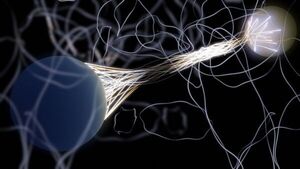
Quantum breakthrough: Chinese scientists realize faster way of quantum key distribution
"Chinese scientists have successfully implemented a new way of quantum key distribution (QKD) which can boost the speed of intercity quantum networks. Quantum network is known for its strong resistance against eavesdropping – theoretically, it's completely hacker-free. Data transferred through this kind of network is encrypted, with the decryption key transferred through quantum mechanics. Current QKD methods have limited distances and can be challenging to implement, but the new method demonstrated hope to solve these problems. The new method, named mode-pairing QKD (MP-QKD), was first proposed in 2022 by a research team led by Dr. Ma Xiongmeng at Tsinghua University. It does not require a technically challenging step called "phase locking" to be implemented." [...]

Scientists boost quantum signals while reducing noise
"“Squeezing” noise over a broad frequency bandwidth in a quantum system could lead to faster and more accurate quantum measurements. A certain amount of noise is inherent in any quantum system. For instance, when researchers want to read information from a quantum computer, which harnesses quantum mechanical phenomena to solve certain problems too complex for classical computers, the same quantum mechanics also imparts a minimum level of unavoidable error that limits the accuracy of the measurements. Scientists can effectively get around this limitation by using “parametric” amplification to “squeeze” the noise –– a quantum phenomenon that decreases the noise affecting one variable while increasing the noise that affects its conjugate partner. While the total amount of noise remains the same, it is effectively redistributed. Researchers can then make more accurate measurements by looking only at the lower-noise variable." [...]

This mathematician went to infinity to bridge two ways of looking at the world
"What happens if you put many particles together, take a few steps back, and squint your eyes a bit? Jasper Hoeksema tried to find out. Particles tend to behave differently once there are a lot of them. The microscopic models that describe their behavior quickly become very hard to calculate, because of the increasing complexity and the sheer volume of the data. This presents a challenge to researchers who are interested at the dynamics of macroscopic systems, such as nature, populations or tumors. By taking the number of particles to infinity, mathematician Jasper Hoeksma has developed a way to come up with mathematical equations that work at both levels." [...]

Solving a machine-learning mystery
"A new study shows how large language models like GPT-3 can learn a new task from just a few examples, without the need for any new training data. Large language models like OpenAI’s GPT-3 are massive neural networks that can generate human-like text, from poetry to programming code. Trained using troves of internet data, these machine-learning models take a small bit of input text and then predict the text that is likely to come next. But that’s not all these models can do. Researchers are exploring a curious phenomenon known as in-context learning, in which a large language model learns to accomplish a task after seeing only a few examples — despite the fact that it wasn’t trained for that task. For instance, someone could feed the model several example sentences and their sentiments (positive or negative), then prompt it with a new sentence, and the model can give the correct sentiment." [...]

Entangled atoms across the Innsbruck quantum network
"Trapped ions have previously only been entangled in one and the same laboratory. Now, teams led by Tracy Northup and Ben Lanyon from the University of Innsbruck have entangled two ions over a distance of 230 meters. The experiment shows that trapped ions are a promising platform for future quantum networks that span cities and eventually continents. Trapped ions are one of the leading systems to build quantum computers and other quantum technologies. To link multiple such quantum systems, interfaces are needed through which the quantum information can be transmitted. In recent years, researchers led by Tracy Northup and Ben Lanyon at the University of Innsbruck’s Department of Experimental Physics have developed a method for doing this by trapping atoms in optical cavities such that quantum information can be efficiently transferred to light particles." [...]

Scientists develop graphene aerogel particles for efficient water purification
"Writing in the Journal of Molecular Liquids, a team led by Professor Aravind Vijayaraghavan based in the National Graphene Institute (NGI) have produced 3-dimensional particles made of graphene, of many interesting shapes, using a variation of the vortex ring effect. The same effect is used to produce smoke rings and is responsible for keeping dandelion seeds flying. These particles have also been shown to be exceptionally efficient in adsorbing contaminants from water, thereby purifying it. The researchers have shown that the formation of these graphene particles is governed by a complex interplay between different forces such as viscosity, surface tension, inertia and electrostatics. Prof Vijayaraghavan said: “We have undertaken a systematic study to understand and explain the influence of various parameters and forces involved in the particle formation. Then, by tailoring this process, we have developed very efficient particles for adsorptive purification of contaminants from water”." [...]
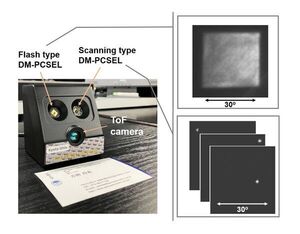
Compact, non-mechanical 3D lidar system could make autonomous driving safer
"Unique, chip-based light source allows scanning lidar to be combined with 3D flash lidar Our roads might one day be safer thanks to a completely new type of system that overcomes some of lidar’s limitations. Lidar, which uses pulsed lasers to map objects and scenes, helps autonomous robots, vehicles and drones to navigate their environment. The new system represents the first time that the capabilities of conventional beam-scanning lidar systems have been combined with those of a newer 3D approach known as flash lidar. In Optica, Optica Publishing Group’s journal for high-impact research, investigators led by Susumu Noda from Kyoto University in Japan describe their new nonmechanical 3D lidar system, which fits in the palm of the hand. They also show that it can be used to measure the distance of poorly reflective objects and automatically track the motion of these objects. “With our lidar system, robots and vehicles will be able to reliably and safely navigate dynamic environments without losing sight of poorly reflective objects such as black metallic cars,” said Noda." [...]

Watching Out for Radiation
"Researchers at the University of Tsukuba create a new lithium-based scintillator crystal for detecting radiation that can distinguish between neutrons and gamma rays, which may lead to improved airport security and nuclear tracking Tsukuba, Japan—Security concerns over radioactive materials have persisted for many years. Airports and other public locations now routinely employ radiation detectors, and nuclear regulators need to be able to monitor the levels of subatomic particles like neutrons. Now, a team of researchers led by the University of Tsukuba has tested a new method of scintillation radiation detection based on wavelength information rather than waveform. In a study published this month in Progress of Theoretical and Experimental Physics, researchers from the Faculty of Pure and Applied Sciences at the University of Tsukuba showed how to detect and distinguish between neutron and gamma-ray sources using data from scintillator emission wavelengths. Often, detectors known as scintillators are used for this purpose. The physical principle of scintillation is similar to the more familiar types of glow-in-the-dark phenomena, such as fluorescence and phosphorescence." [...]

Atom-thin walls could smash size, memory barriers in next-gen devices
"For all of the unparalleled, parallel-processing, still-indistinguishable-from-magic wizardry packed into the three pounds of an adult human brain, it obeys the same rule as the other living tissue it controls: Oxygen is a must. So it was with a touch of irony that Evgeny Tsymbal offered his explanation for a technological wonder — movable, data-covered walls mere atoms wide — that may eventually help computers behave more like a brain. “There was unambiguous evidence that oxygen vacancies are responsible for this,” said Tsymbal, George Holmes University Professor of physics and astronomy at the University of Nebraska–Lincoln. In partnership with colleagues in China and Singapore, Tsymbal and a few Husker alumni have demonstrated how to construct, control and explain the oxygen-deprived walls of a nanoscopically thin material suited to next-gen electronics. Unlike most digital data-writing and -reading techniques, which speak only the binary of ones and zeroes, these walls can talk in several electronic dialects that could allow the devices housing them to store even more data. Like synapses in the brain, the passage of electrical spikes sent via the walls can depend on which signals have passed through before, lending them an adaptability and energy-efficiency more akin to human memory." [...]
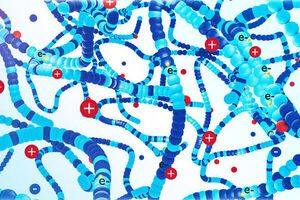
New polymers could enable better wearable devices
"MIT engineers developed organic polymers that can efficiently convert signals from biological tissue into the electronic signals used in transistors. Certain electronics that integrate with the human body — a smartwatch that samples your sweat, for instance — work by converting the ion-based signals of biological tissue into the electron-based signals used in transistors. But the materials in these devices are often designed to maximize ion uptake while sacrificing electronic performance. To remedy this, MIT researchers developed a strategy to design these materials, called organic mixed ionic-electronic conductors (OMIECs), that brings their ionic and electronic capabilities into balance. These optimized OMIECs can even learn and retain these signals in a way that mimics biological neurons, according to Aristide Gumyusenge, the Merton C. Flemings Assistant Professor of Materials Science and Engineering. “This behavior is key to next-generation biology-inspired electronics and body-machine interfaces, where our artificial components must speak the same language as the natural ones for a seamless integration,” he says." [...]
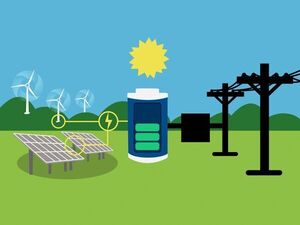
New Sodium, Aluminum Battery Aims to Integrate Renewables for Grid Resiliency
"A new battery design could help ease integration of renewable energy into the nation's electrical grid at lower cost, using Earth-abundant metals, according to a study just published in Energy Storage Materials. A research team, led by the Department of Energy's Pacific Northwest National Laboratory, demonstrated that the new design for a grid energy storage battery built with the low-cost metals sodium and aluminum provides a pathway towards a safer and more scalable stationary energy storage system. "We showed that this new molten salt battery design has the potential to charge and discharge much faster than other conventional high-temperature sodium batteries, operate at a lower temperature, and maintain an excellent energy storage capacity," said Guosheng Li, a materials scientist at PNNL and the principal investigator of the research. "We are getting similar performance with this new sodium-based chemistry at over 100 °C [212 °F] lower temperatures than commercially available high-temperature sodium battery technologies, while using a more Earth-abundant material." More energy storage delivered Imre Gyuk, director of DOE's Office of Electricity, Energy Storage Program, which supported this research, noted "This battery technology, which is built with low-cost domestically available materials brings us one step closer toward meeting our nation's clean energy goals." The new sodium-based molten salt battery uses two distinct reactions." [...]
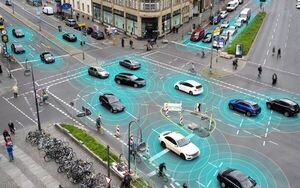
Autonomous driving: New algorithm distributes risk fairly
"Researchers at the Technical University of Munich (TUM) have developed autonomous driving software which distributes risk on the street in a fair manner. The algorithm contained in the software is considered to be the first to incorporate the 20 ethics recommendations of the EU Commission expert group, thus making significantly more differentiated decisions than previous algorithms. Operation of automated vehicles is to be made significantly safer by assessing the varying degrees of risk to pedestrians and motorists. The code is available to the general public as Open Source software. Technical realization is not the only obstacle to be mastered before autonomously driving vehicles can be allowed on the street on a large scale. Ethical questions play an important role in the development of the corresponding algorithms: Software has to be able to handle unforeseeable situations and make the necessary decisions in case of an impending accident." [...]

A new ring system discovered in our Solar System
"Scientists have discovered a new ring system around a dwarf planet on the edge of the Solar System. The ring system orbits much further out than is typical for other ring systems, calling into question current theories of how ring systems are formed. The ring system is around a dwarf planet, named Quaoar, which is approximately half the size of Pluto and orbits the Sun beyond Neptune. The discovery, published in Nature, was made by an international team of astronomers using HiPERCAM -- an extremely sensitive high-speed camera developed by scientists at the University of Sheffield which is mounted on the world's largest optical telescope, the 10.4 metre diameter Gran Telescopio Canarias (GTC) on La Palma. The rings are too small and faint to see directly in an image. Instead, the researchers made their discovery by observing an occultation, when the light from a background star was blocked by Quaoar as it orbits the Sun." [...]

Sussex scientists make breakthrough in developing quantum computers that can solve big challenges of our time
"Researchers from the University of Sussex and Universal Quantum have demonstrated for the first time that quantum bits (qubits) can directly transfer between quantum computer microchips and demonstrated this with record-breaking speed and accuracy. This breakthrough resolves a major challenge in building quantum computers large and powerful enough to tackle complex problems that are of critical importance to society. Today, quantum computers operate on the 100-qubit scale. Experts anticipate millions of qubits are required to solve important problems that are out of reach of today’s most powerful supercomputers [1, 2]. There is a global quantum race to develop quantum computers that can help in many important societal challenges from drug discovery to making fertilizer production more energy efficient and solving important problems in nearly every industry, ranging from aeronautics to the financial sector. In the research paper, published today (Wednesday 8 February 2023) in Nature Communications, the scientists demonstrate how they have used a new and powerful technique, which they dub ‘UQ Connect’, to use electric field links to enable qubits to move from one quantum computing microchip module to another with unprecedented speed and precision." [...]

How to reverse unknown quantum processes
"Time evolution of a single photon reversed with a universal rewinding protocol and a quantum switch. In the world around us processes appear to follow a certain time-direction: dandelions eventually turn into blowballs. However, the quantum realm does not play by the same rules. Physicists from the University of Vienna and IQOQI Vienna have now shown that for certain quantum systems the time-direction of processes can be reversed. This demonstration of a so-called rewinding protocol has been published in the Journal "Optica". Everyday life is full of changes that are well understood, yet practically impossible to reverse, for example, the metamorphosis of a dandelion into a blowball." [...]

Tuning Local Coordination of Catalysts for Better Lithium-Sulfur Batteries
"A research team led by Prof. ZHU Qingshan from the Institute of Process Engineering (IPE) of the Chinese Academy of Sciences investigated the electronic structure transition from NiAs- to MnP- type CoPxS1-x compounds and how the transition influences catalytic activity of polysulfide conversion reactions in lithium-sulfur batteries. The study was published in ACS Nano on Jan. 30. Lithium-sulfur batteries are promising energy storage systems due to their high theoretic capacity and specific energy. However, polysulfide shuttling leads to the decay of batteries, limiting their practical applications. Catalysts can accelerate the conversion of polysulfides and relatively suppress the shuttling, which serves as the effective approach to improving cyclability of Li-S batteries. The lack of understanding of the catalytic mechanism and origin poses an obstacle to the design of Li-S catalysts." [...]
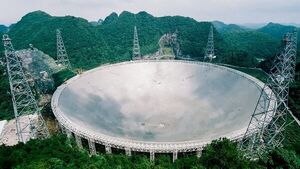
China's FAST Telescope Detects More Than 740 Pulsars
"Scientists have identified over 740 pulsars since October 2017 with the help of the 500-meter Aperture Spherical Radio Telescope (FAST), also dubbed as the "China Sky Eye." Jiang Peng, chief engineer of FAST and researcher at the National Astronomical Observatories of China, told China Media Group (CMG) that as the number of discovered pulsars continues to increase in the future, scientists can use them to test arrays for evidence of gravitational waves, or establish an autonomous and controllable time reference system. "What we expect more is to discover a special type of pulsar, such as a binary star system paired with a black hole, so that we can test the correctness of Einstein's theory of relativity under more extreme gravitational field conditions." In 2023, along with ensuring the smooth operation of the FAST system and discovering more unknown mysteries in the universe, construction plans for pilot arrays are also being prepared, Jiang added. Pulsars, or fast-spinning neutron stars, originate from the imploded cores of massive dying stars through supernova explosions. With their high density and fast rotation, they are an ideal laboratory for studying the laws of physics in extreme environments." [...]
Projetos Maker
Diversos Projetos interessantes.
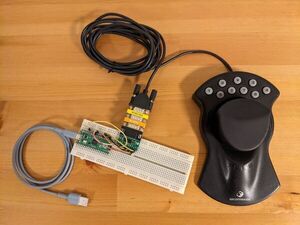
RS-232 Magellan/SpaceMouse with modern software
"This project lets you use an old serial Magellan/SpaceMouse controller with modern software on modern operating systems. It simulates a 3DConnexion SpaceMouse Compact, so it can be used with software like Fusion 360, 3ds Max, SolidWorks, Inventor, Maya and many others. No special software is required on the computer, apart from 3DxWare. From the computer's point of view, your old Magellan will look like a real SpaceMouse Compact connected over USB. To make it work you will need: - Raspberry Pi Pico - Pololu 23201a Serial Adapter - null modem adapter and DB9 gender changer (either as two separate adapters or one that does both) - breadboard and some jumper wires" [...]

Paper Sundial Kits
"A sundial can track the Sun's movement throughout the day and year, turning it into a clock, compass, and calendar. There are many types of sundials from relatively simple ones to ones that are quite complex. My intent is not to teach you about these sundials and how they work but I want everyone to be able to enjoy making a sundial that will actually work. If you would like to learn more about a wide variety of sundials then I invite you to visit my web site. There you will find information on how to design and build many different sundials. The link to my site is provided in the last section of this instructable." [...]

NodeMCU, ESP8266 and ESP32 Spy Microphone Arduino code
"Here is another update for the “ESP Spy Microphone” project which is ESP8266/NodeMCU and ESP32 WiFi microphone arduino source code, revision 1.5. In this update I have increased the audio stream recorder sample rate to 240KHz for both of ESP8266 and ESP32 firmwares. Also the new feature is the “Chain Network” which is a local network that the devices one by one are connected to the each other and can transfer the audio stream data to the “Web Application”. " [...]
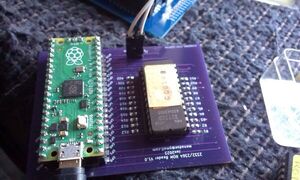
Getting ROM Dumps by Post
"What do you do if you want to dump the ROM in some equipment that is owned by someone else, who is happy to have their ROMs dumped, but who live in another country? they are probably not too happy sending things through the postal system as loss and damage is common these days. To solve this problem (and also allow me to dump some of my own ROMs) i made a little gadget that can dump a ROM that is plugged into it. Plug in the ROM, power up the gadget and wait for an LED to flash and you are done. The gadget can be posted to whoever has the ROM, they plug the ROM in and turn the unit on. After the light flashes, the unit is sent back to the person who needs the ROM dump." [...]
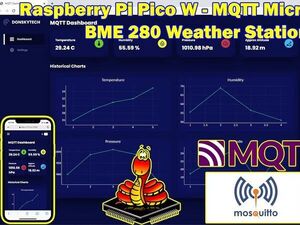
Raspberry Pi Pico W - MicroPython MQTT - BMP/BME 280 Weather
"This is an example Raspberry Pi Pico W BMP/BME 280 Weather station project that I built using MicroPython framework and MQTT. In this tutorial, I am going to share with you my Raspberry Pi Pico W-powered MicroPython MQTT project that uses BMP/BME 280 sensor to display its sensor readings in almost real-time. We are going to publish MQTT messages to our broker and display the sensor readings in a custom dashboard that will show it in both text and graphical chart format. " [...]
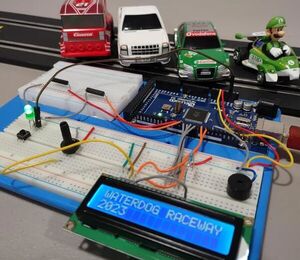
DIY Arduino Slot Car Timer and Lap Counter
"The goal of this Instructable was to build a lap timer and lap counter for my son's Carrera 1:43 slot car set. While the mechanical lap counter worked as it should we wanted to start logging the lap times of cars. Therefore, the hunt for a timing solution. Since most of my time and money has been dedicated to my 1:32/1:24 track setup, I needed an inexpensive solution. As an Arduino hobbyist, I already had all the pieces and parts to make this happen. Great economical solution!" [...]

Autonomous Driving Car V2
"Curious about autonomous driving, AI and neural networks? Build your own autonomous driving car and get your hands on these topics! This project is all about building a cool self-driving car using some fun and exciting technology! We'll be using a Raspberry Pi as the driver of the car to make all the decisions and see the world through a camera. We'll also be using a XMC microcontroller board to control the car's steering and speed. To make the car move, we'll be using a Motix DC motor shield that sits on top of the XMC boot kit." [...]

SEEED Wio Terminal LoRa MQTT Gateway using Arduino IDE
"Transform your Wio Terminal into a Matrix LoRa MQTT Gateway. Transmit received LoRa messages to a MQTT Broker and act as SensorNode too. In today’s article, we are going to build a Matrix LoRa MQTT Gateway with your Wio Terminal ! This project sets up Wio Terminal as a LoRa gateway, but also it acts as a own SensorNode via the MQTT protocol too. To demonstrate the function and features of this gateway you can build a small SensorNode with a Seeed Xiao and some Grove actors and sensors. Wio Terminal The Wio Terminal is a SAMD51-based microcontroller with Wireless Connectivity supported by Realtek RTL8720DN that’s compatible with Arduino and MicroPython." [...]
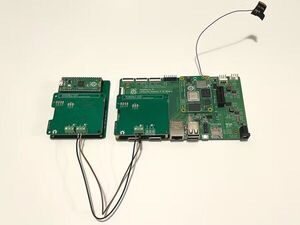
Simple CAN BUS Logger with PICO
"With Raspberry PICO and a couple of CAN BUS interfaces it is possible to perform a simple can bus logger. SG Electronic Systems was born as a support to the Open Hardware projects. Our experience allows us to support the Open Hardware team in the development of new electronic systems and in their distribution. We have a long experience in Fieldbus applications as: CAN BUS, RS-232, RS-422/485, Ethernet. In this tutorial we explain how to program the Raspberry PICO as a double CAN BUS logger. The hardware setup is composed by Master Board (to send CAN BUS data) and Slave Board (for message recording)." [...]

Induction Heater, Power Supply, and HV Source from CFL Bulb
"An interesting project that describes how to make several useful devices using a CFL bulb ballast, with minimal modification. This time I will present you an interesting way to use the PCB board from an old CFL bulb to make some useful electronic devices. As we know, these bulbs are no longer in use, so we can buy from the remaining stock for a very low price. I bought 24 watt CFL bulb for less than $2. I noticed the genius idea these days at the Zafer Yildiz channel and immediately decided to make some kind of device with a CFL bulb electronic board. We can remove the PCB relatively easily with a screwdriver." [...]
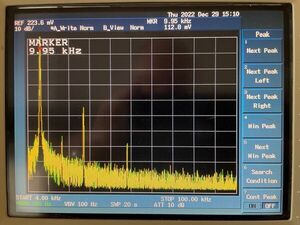
Fake Parallel Printer - A Parallel Port Traffic Capturing Tool
"Here’s a executive summary of the fake printer features and design decisions: DB-25 connector on a PCB that plugs straight into the instrument USB acting as serial port to transmit captured data to the PC Raspberry Pico as microcontroller DB-25 instead of Centronics Connector The Retro-Printer solution has a Centronics port, just like a real printer. I’m using DB-25 connector instead. The reason is cost and, IMO, convenience. On Digikey, the DB-25 connector is $1.60 versus $7.10 for the Centronics one. And if you use the Centronics connector, you need a bulky DB-25 to Centronics cable too, good for an additional $12! And now you have 2 cables to deal with: the printer cable and the USB cable from the fake printer back to your PC." [...]

LEVITATING BANANA - Electromagnetic Levitation
"I shall be demonstrating how to levitate a banana. Your first thought would be, "Why?". How often do you see objects floating in thin air, and how often do you see a banana floating in thin air? Being able to levitate an object is impressive and can amuse your peers. You can learn a lot about electronics and gain practical knowledge from building this project(which is relatively easy to make),. Personally, I learned quite a lot from it." [...]

Decorative Analog LED Strip IoT Clock
"An analog IoT LED clock running on an ESP8266, driving a WS2812B LED strip, constantly synched using an NTP server and controlled by your smartphone via a web server. Actually, It is not that complicated and all of the above is really easy to achieve if you already have some experience with Arduino, ESP, LED strips, and basic coding. I wanted to make this clock for a long time ago, and I even found some projects here, but none of them had all the key features I visioned in mind, and the way I see it, It had to have all of these properties: - Decorative - a clock I would want to hang in my living room. - Analog - we already have millions of DIY digital clocks. - Light projection - outwards and inwards. - Easy to build - Snap fit, no screws, minimum joints, and easy to construct." [...]

Shouting Rock
"Hacked artificial outdoor Shouting Rock, controlled by HomeAssistant MQTT automation. Intro and Inspiration In the prophecy of Chavakuk (Habakkuk) Chapter 2 verse 11, it is written: "For a stone shall cry from the wall, and a chip shall answer it from a beam." This prophecy depicts the state of physical matter during the time of redemption, as also prophesied by Isaiah in Chapter 40 verse 5: "And the glory of the Lord shall be revealed, and all flesh together shall see that the mouth of the Lord spoke." As explained in Chabad Legacy, these prophecies indicate that the revelation of the Almighty will be revealed in both the earth and the flesh. The arrival of the Messiah and the revelation of the reality of the Almighty is the purpose and focus of this time. Inspired by these verses, I created the "A stone from a wall that calls out" representation." [...]
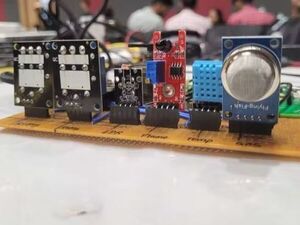
IoT assistive device
"Device that creates smarter and more connected home by integrating various household functions and providing real-time data about the home. " [...]
Secção Videos
Videos interessantes.
That's all Folks!



